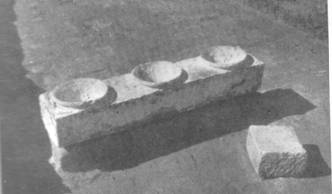W490

Mae’r eitem hon o dŷ T36.11 ym Maestref y Gogledd, Amarna. (Frankfort a Pendlebury 1933, 25, plâu. XII, XX.3). Mae’n 123cm o hyd. Cafwyd hi yn ymyl ystafell ymolchi’r tŷ a dywedir ei bod yn cynnwys ‘traces of grease’. Nid yw’n amlwg beth oedd ei phwrpas. Efallai i eitem debyg gael ei darganfod yn Deir el-Medina (Kemp 1985, 50) a chafwyd meinciau gyda chynwysyddion crwn yng Nghapel 528 Pentref y Gweithwyr (Kemp 1985, 43, fig.4.4). Roedd cynwysyddion rhai Pentref y Gweithwyr yn rhy agos at ei gilydd i fod wedi cael eu defnyddio fel standiau crochenwaith.
Cafwyd yr eitem hon yn yr un ystafell ag W344, gorffwysydd pen neu stôl sydd i’w gweld yn y Ganolfan. Roedd y tŷ lle y cafwyd y gwrthrych y mwyaf o gryn lawer ym maestref y Gogledd. Fel hyn y mae Frankfort a Pendelbury (1933, 25) yn disgrifio’r bloc:
The bath is standing behind a screen wall in what we have called the ‘anointing room’ (pl.p.1, 3) because we found a long block of limestone there with three cups with traces of grease; whether ointment or oil was poured into the cups or whether the cups merely served to steady vessels which were put on the blocks we cannot decide. The grease in the cups was not very extensive or deeply sunk in, so the last assumption is the most probable. The block fits exactly on a ridge on seven bricks which are plastered to the floor…which is not quite in line with any wall.
Hefyd gweler Stevens 2003.
Llyfryddiaeth
Frankfort, H. a Pendlebury, J.D.S. 1933. The City of Akhenaten. II. The North Suburb and The Desert Altars. Llundain: Egypt Exploration Society.
Kemp, B.J. 1985. Report on the 1984 excavations chapel group 528-531. In Kemp, B.J., Amarna Reports II. Llundain: Egypt Exploration Society, 39-50.
Stevens, A. 2003. The material evidence for domestic religion at Amarna and preliminary remarks on its interpretation. Journal of Egyptian Archaeology 89, 144-168.
Eitemau eraill o Amarna yn y Ganolfan Eifftaidd